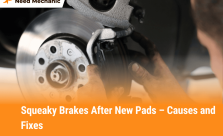How often should you get your brakes checked? The short answer is: at least every 6 months or 6,000 to 10,000 miles. Your brakes are one of the most important safety systems on your car, and regular inspections can catch problems before they turn into expensive or dangerous failures. In this guide, we’ll explain how often brake checks should be done, what affects that timing, signs to watch for, and how you can keep your car stopping safely with minimal effort.
Why Brake Checks Are So Important
Brakes are your first line of defense on the road. If they fail or wear down, the results can be dangerous. Brake systems are made up of multiple moving parts, including brake pads, rotors, calipers, and brake fluid. Over time, these components wear out, and if they’re not inspected regularly, they can fail when you need them most.
Regular brake checks:
- Help catch problems early before they become serious
- Improve vehicle handling and stopping distance
- Keep you and your passengers safe
- Extend the lifespan of your brake system
- Save you money on expensive repairs later
So, How Often Should You Get Your Brakes Checked?
The general rule: get your brakes inspected at least once every 6 months or every 6,000 to 10,000 miles whichever comes first.
But this isn’t a one-size-fits-all number. How often you need to check your brakes depends on several factors:
1. Driving Habits
If you brake hard often, drive in heavy traffic, or live in a hilly area, your brakes wear out faster. Frequent stop-and-go driving causes more stress on your brake pads than highway driving.
Recommendation: Inspect every 6,000 miles or 6 months, especially if you’re a daily driver in urban areas.
2. Vehicle Type
Trucks, SUVs, and performance cars often have larger or more complex brake systems. These may need inspections more frequently due to heavier loads or higher speeds.
3. Road Conditions
If you regularly drive on rough, dusty, or gravel roads, your brakes can collect debris or wear unevenly, making frequent checks essential.
4. Manufacturer’s Guidelines
Your owner’s manual has the most accurate recommendation for your car model. Some newer cars even have built-in wear sensors that alert you when your pads are low.
Warning Signs You Need a Brake Inspection Immediately
While regular brake checks are part of good vehicle maintenance, there are signs that indicate urgent attention is needed:
1. Squeaking or Squealing
A high-pitched squeal means your brake pads are wearing thin. Most pads have wear indicators that make noise when it’s time to replace them.
2. Grinding Noise
Grinding usually means the brake pad has worn completely, and metal is rubbing against metal. This can damage your rotors, leading to costly repairs.
3. Vibration or Shaking When Braking
Warped rotors often cause vibration when applying the brakes. This affects braking performance and safety.
4. Longer Stopping Distance
If it’s taking more time or distance to come to a stop, your brakes may be worn or low on fluid.
5. Brake Warning Light
If the brake light or ABS light is on, don’t ignore it. It’s your car’s way of saying something’s not right.
6. Spongy or Soft Brake Pedal
If your brake pedal feels soft, it could mean there’s air in the brake lines or a leak in the brake fluid system.
What Happens During a Brake Inspection?
A proper brake inspection covers more than just a quick glance. Here’s what a mechanic typically checks:
- Brake Pads – Thickness and wear pattern
- Brake Rotors/Drums – Smoothness, warping, and wear
- Brake Calipers – Movement and leaks
- Brake Fluid – Level, condition, and contamination
- Brake Lines and Hoses – Signs of damage or leaks
- Parking Brake – Functionality and cable tension
Many auto shops offer free brake inspections, especially if you’re already there for tire rotation or oil change. It’s a smart time to double up on maintenance.
How Long Do Brake Components Typically Last?
Each brake component wears at its own pace. Here’s an average timeline:
| Part | Average Lifespan |
| Brake Pads | 25,000–70,000 miles |
| Brake Rotors | 50,000–70,000 miles |
| Brake Fluid | Every 2–3 years or as needed |
| Brake Calipers | 75,000–100,000 miles |
Keep in mind, these are averages. Driving aggressively or in extreme conditions can shorten these timeframes.
What Happens If You Skip Brake Inspections?
Ignoring your brakes is a recipe for danger and high costs. If you wait too long:
- Pads wear down completely, causing rotor damage
- Rotors warp or crack, needing costly replacement
- Brake fluid gets contaminated, affecting braking power
- Entire brake system could fail, putting you and others at risk
Small issues can snowball into big ones if left unchecked. The cost of routine checks is far less than major repairs or worse, an accident.
Can You Check Brakes Yourself?
Yes, basic brake checks can be done at home if you’re comfortable and know what to look for. Here’s how:
- Listen for Noises – Go for a short drive and listen when you brake.
- Look Through the Wheel – Some brake pads are visible through the wheel spokes. If the pad is less than 1/4 inch thick, it’s time to replace it.
- Check Fluid Level – Find your brake fluid reservoir under the hood and see if it’s at the recommended level.
However, a professional brake inspection includes checking components you can’t easily see like inside brake calipers and underbody brake lines. So DIY checks are helpful, but not a replacement for regular shop visits.
Best Times to Schedule a Brake Inspection
If you’re not sure when to check your brakes, here are some smart times to add it to your schedule:
- During Oil Changes – Many shops offer a quick brake inspection as part of the service.
- Before Long Road Trips – Make sure your car is road-ready and safe.
- When Rotating Tires – Another great opportunity to check brakes while the wheels are off.
- Every 6 Months – Mark your calendar or add a reminder.
How Much Does a Brake Inspection Cost?
Many local repair shops and tire centers offer free brake inspections, especially if you’re getting another service like an oil change or tire replacement. If there is a charge, it typically ranges from $20 to $40.
However, if repairs are needed after the inspection, expect these average costs:
- Brake Pad Replacement: $100–$300 per axle
- Rotor Replacement: $200–$400 per axle
- Brake Fluid Flush: $70–$120
Early inspections help you avoid bigger, more expensive repairs.
Brake Maintenance Tips to Extend Lifespan
Want to get the most out of your brakes and reduce how often they need repairs? These tips help:
- Drive Smoothly – Avoid slamming your brakes whenever possible.
- Keep a Safe Distance – You won’t need to brake as hard or as often.
- Lighten Your Load – Less weight means less strain on the brake system.
- Downshift on Hills – Use engine braking when driving downhill.
- Flush Brake Fluid Regularly – Prevents corrosion and keeps your brake lines clean.
Final Thoughts
Getting your brakes checked regularly is one of the simplest ways to stay safe and avoid expensive repairs. Even if everything feels normal, experts recommend that you get your brakes checked every 6 months or every 6,000 to 10,000 miles to catch wear and tear early. Waiting too long can lead to bigger problems like damaged rotors, longer stopping distances, or even brake failure. Staying on schedule helps protect your passengers, extend the life of your braking system, and keep your vehicle ready for whatever the road brings. Make brake checks a regular habit, and you’ll drive with greater peace of mind every day.
FAQs
How often should brakes be checked?
You should get your brakes checked every 6 months or 6,000 to 10,000 miles to stay safe and catch problems early before they become expensive.
When should I inspect brake pads?
Inspect brake pads once a year or sooner if you drive in traffic, on hills, or hear squealing or grinding noises while stopping your car.
How often to change brake fluid?
Brake fluid should be changed every 2 to 3 years. Old fluid can cause poor braking, soft pedals, and damage your brake system over time.
Signs brakes need immediate check?
Get your brakes checked if you hear grinding, feel shaking, notice longer stops, or see a warning light on your dashboard while driving.
Does driving in city need more brake checks?
Yes, if you drive in traffic, on hills, or brake often, check your brakes more than twice a year since they wear down faster in those conditions.
How long do brake pads typically last?
Brake pads usually last between 25,000 and 70,000 miles. Hard stops, towing, or hilly roads can wear them out faster, so check them regularly.
Should brakes be checked during oil change?
Yes, checking brakes during oil changes is smart. Many shops do it free, and it helps catch early wear before it causes bigger problems.
Can skipping brake checks cost money or safety?
Skipping brake checks can lead to bad pads, ruined rotors, and even crashes. Routine checks help avoid big repairs and keep you safer.






Leave a Reply